
Simon & Garfunkel were an American folk rock duo consisting of singer-songwriter Paul Simon and singer Art Garfunkel. One of the best-selling music acts of the 1960s, their most famous recordings include three US number ones: "The Sound of Silence" (1965) and the two Record of the Year Grammy winners "Mrs. Robinson" (1968) and "Bridge over Troubled Water" (1970). Other hits include "The Boxer" (1969), "Cecilia" (1970) and the four 1966 releases "Homeward Bound", "I Am a Rock", "Scarborough Fair/Canticle" and "A Hazy Shade of Winter", as well as the 1968 album track "America".
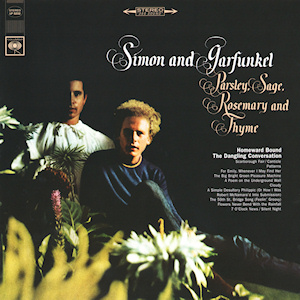
Parsley, Sage, Rosemary and Thyme is the third studio album by American folk rock duo Simon & Garfunkel. Produced by Bob Johnston, the album was released on October 24, 1966, in the United States by Columbia Records. Following the success of the re-release of their debut single "The Sound of Silence", Simon & Garfunkel regrouped after a time apart while Columbia issued their second album, a rushed collection titled Sounds of Silence. For their third album, the duo spent almost three months in the studio working on instrumentation and production.

Paul Frederic Simon is an American singer-songwriter known both for his solo work and his collaboration with Art Garfunkel. He and his school friend Garfunkel, whom he met in 1953, came to prominence in the 1960s as Simon & Garfunkel. Their blend of folk and rock, including hits such as "The Sound of Silence", "Mrs. Robinson", "America" and "The Boxer", served as a soundtrack to the counterculture movement. Their final album, Bridge Over Troubled Water (1970), is among the bestselling of all time.

"The Sound of Silence" is a song by the American folk rock duo Simon & Garfunkel, written by Paul Simon. The duo's studio audition of the song led to a record deal with Columbia Records, and the original acoustic version was recorded in March 1964 at Columbia's 7th Avenue Recording Studios in New York City for their debut album, Wednesday Morning, 3 A.M., released that October to disappointing sales. An overdubbed electric remix was released the following year and went to number one on the Billboard singles chart.

"Bridge over Troubled Water" is a song by the American folk rock duo Simon & Garfunkel, released in January 1970 as the second single from their fifth studio album, Bridge over Troubled Water (1970). It was written by Paul Simon and produced by Simon, Art Garfunkel and Roy Halee.

"The Boxer" is a song written by Paul Simon and recorded by the American music duo Simon & Garfunkel from their fifth and final studio album, Bridge over Troubled Water (1970). Produced by the duo and Roy Halee, it was released as a standalone single on March 21, 1969, but included on the album nine months later. The song is a folk rock ballad that variously takes the form of a first-person lament as well as a third-person sketch of a boxer. The lyrics are largely autobiographical and partially inspired by the Bible and were written during a time when Simon felt he was being unfairly criticized. The song's lyrics discuss poverty and loneliness. It is particularly known for its plaintive refrain, in which they sing 'lie-la-lie', accompanied by a heavily reverbed snare drum.

"I Am a Rock" is a song written by Paul Simon. It was first performed by Simon alone as the opening track on his album The Paul Simon Songbook which he originally recorded and released in August 1965, only in the United Kingdom. Paul Simon and Art Garfunkel, as the American folk rock duo Simon & Garfunkel, re-recorded it on December 14, 1965, and included as the final track on their album Sounds of Silence, which they released on January 17, 1966. It was released as a single in 1966, and subsequently included as the B-side of the 1971 A-side reissue of "The 59th Street Bridge Song ".

"Mother and Child Reunion" is a song by the American singer-songwriter Paul Simon. It was the lead single from his second studio album, Paul Simon (1972), released on Columbia Records. The song reached No. 4 on the Billboard Hot 100 chart in March 1972.

"Mrs. Robinson" is a song by American folk rock duo Simon & Garfunkel from their fourth studio album, Bookends (1968). The writing of the song was begun before the 1967 film The Graduate, which contained only fragments of it. The full song was released as a single on April 5, 1968, by Columbia Records. Produced by the duo and Roy Halee, the song was written by Paul Simon, who offered parts of it to movie director Mike Nichols alongside Art Garfunkel after Nichols rejected two other songs intended for the film. The Graduate's soundtrack album uses two short versions of "Mrs. Robinson"; The full song was published on the album Bookends. The song was additionally released on the Mrs. Robinson EP in 1968, which also included three other songs from the film: "April Come She Will", "Scarborough Fair/Canticle", and "The Sound of Silence".

"Cecilia" is a song by American musical duo Simon & Garfunkel. It was released in April 1970 as the third single from the duo's fifth and final studio album, Bridge over Troubled Water (1970). Written by Paul Simon, the song's origins lie in a late-night party, in which the duo and friends began banging on a piano bench. They recorded the sound with a tape recorder, employing reverb and matching the rhythm created by the machine. Simon later wrote the song's guitar line and lyrics on the subject of an untrustworthy lover.
"El Cóndor Pasa" is an orchestral musical piece from the zarzuela El Cóndor Pasa by the Peruvian composer Daniel Alomía Robles, written in 1913 and based on traditional Andean music, specifically folk music from Peru.
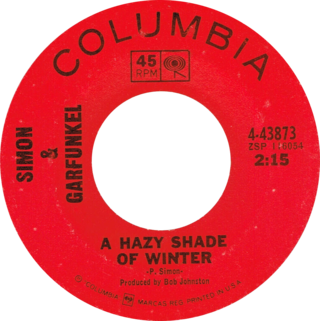
"A Hazy Shade of Winter" is a song by American music duo Simon & Garfunkel, released on October 22, 1966, initially as a stand-alone single, but subsequently included on the duo's album Bookends (1968). It peaked at number 13 on the Billboard Hot 100.

"The Dangling Conversation" is a song by American music duo Simon & Garfunkel, released in September 1966 as the second single from the duo's third studio album, Parsley, Sage, Rosemary and Thyme (1966).
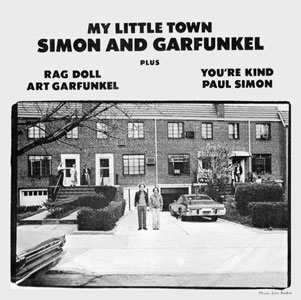
"My Little Town" is a 1975 song by the American duo Simon & Garfunkel. It was written by Paul Simon, who produced the track along with Art Garfunkel and Phil Ramone. The song was included on the 1975 solo releases from both Simon and Garfunkel (Breakaway). It would not appear on any of the duo's albums until the 1997 anthology box set Old Friends and the 1999 compilation album The Best of Simon and Garfunkel. It was the first single release credited to the duo since the 1972 release of "America", released in conjunction with Simon and Garfunkel's Greatest Hits.
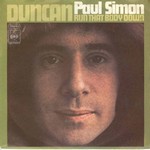
"Duncan" is a song by the American singer-songwriter Paul Simon. It was the third and final single from his second self-titled studio album (1972), released on Columbia Records in July 1972 backed with "Run That Body Down".

"Fakin' It" is a song recorded by American music duo Simon & Garfunkel for their fourth studio album, Bookends (1968). The song was initially released only as a single on July 7, 1967 through Columbia Records. It was later compiled into the second half of Bookends.

"For Emily, Whenever I May Find Her" is a song written by Paul Simon and recorded by American music duo Simon & Garfunkel on their third studio album, Parsley, Sage, Rosemary and Thyme (1966). It is sung solely by Art Garfunkel, and consists mainly of his vocals with heavy reverb and a 12-string acoustic guitar. The lyrics concern finding a lover, although Simon once characterized the subject matter as being about a "belief," rather than about a specific individual.
"Leaves That Are Green" is a song written and originally recorded by Paul Simon for his 1965 album The Paul Simon Songbook. It was later re-recorded with Art Garfunkel for the 1966 album Sounds of Silence, adding an electric harpsichord, rhythm guitar, and bass. It was also the B-side to the hit song "Homeward Bound".

"Still Crazy After All These Years" is a song by the American singer-songwriter Paul Simon. It was the third and final single from his fourth studio album of the same name (1975), released on Columbia Records. Though the song briefly reached the top 40 of the Billboard Hot 100 in the U.S., it was a bigger hit on the magazine's Easy Listening chart, where it peaked at number four.
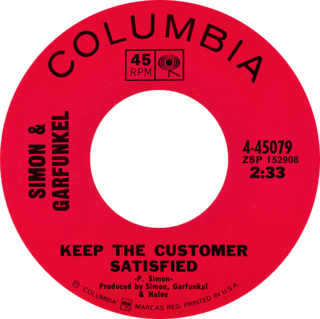
"Keep the Customer Satisfied" is a song by American music duo Simon & Garfunkel from the group's fifth studio album, Bridge over Troubled Water (1970). It was included as the B side of their signature hit, "Bridge over Troubled Water". "Keep the Customer Satisfied" recounts the exhausting tours that Simon grew tired of, a similar theme to that of their earlier song, "Homeward Bound".



















